3.1. SLIDING
OF LINEAR ELEMENTS.
Despite of the some successes, a final solution of the problem
of longitudinal fixing of approximating segments to obtain it was
not possible. It was not possible to fix, for example, these segments
on lateral faces of an iron, and also on a heel of an insole (see fig.13).
Certainly it is possible to consider, that these examples concern to
some degenerated case - too smooth curves. Nevertheless, in the
exhibited examples basic unsteadiness of the edge permitting to distinguish
legibly a case when the contour should be represented with an integral
arc and when - composite one (namely as the approximating segments should
place in a true case on the contour) is shown. Depending on initial
approximations, random interferences, and also not perfecteness
of the form of objects themselves can obtain various representations
- subdivisions - of the contour lines corresponding to identical elements
of observation objects.
This situation
is aggravated also with that in practice a full detection of the
contour boundaries meets rather seldom. Only scraps
of lines are selected. The blacked out pieces (or superlighted)
are badly reflected. Some pieces can be absent basically, - owing to
the possible partial overlapping by other objects. The last circumstance
represents one of the most characteristic peculiarities of a solution
of the problem of object recognition in actual conditions. Generally,
the approximating segments are not fixed on the defined places basically.
All these circumstances
induce to do a conclusion about necessity to build-up the procedures
of integral pose matching in the supposition of a possibility of sliding
of approximating segments on the contour boundaries of the search
objects. Speculations in this occasion as the whole lead to a conclusion
that the separate segment of the simplest form (with feebly
marked changes of curvature), inherently, legibly defines the passing
contour only in the cross direction. Often to understand finally the
longitudinal fixing it is possible only proceeding from integral
models of search contour figures.
Fig.18 illustrates
this position for the simplest cases, particularly, - an incomplete
detection of rectilinear contours (fig.18a).
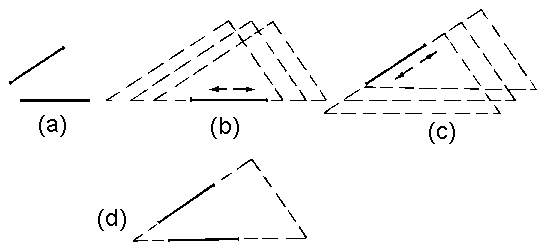
|
Fig.18a,b,c,d
|
Here the chosen
segments correspond to an angle of some figure. This angle can
slide concerning each of the chosen segments (fig.18b,c), and only
the combination of such segments catches this angle legibly
(fig.18d). The similar example for a curvilinear angle (iron),
which for example, is fixed at least by two approximating (contiguous)
segments (and by that defines these segments as the defined
parts of a contour of the search object), is represented on fig.18e.
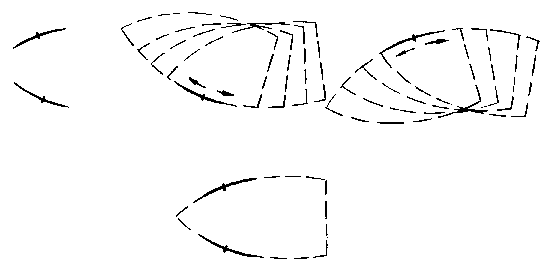
|
Fig.18e
|
Naturally, at
the so poorly fixing - fuzzy - primary-elementary matching of contours the
solution of the integral positional matching problem represents a nontrivial
problem. In this case, the separate segment generates as possible
all those positions of the search object, at which its standard contour
is only juxtaposed with this segment in the cross direction. To choose
a search position among so extensive set generated by each segment of
an observed picture is rather uneasy.
The following
stage of the given work also has been devoted to a solution of
this problem. At this stage the method [19] interpreting the positional
detection problem as accumulation of hypotheses [3], which in the case of objects defined
- fixed - forms allows to solve costructively the positional detection
problem in conditions of sliding primary-elementary matching of contours
has been developed.
3.2. ESSENTIAL STATEMENT OF THE PROBLEM.
Let's make preciser the common sense of problem statement
of positional detection. Let us, it is a triangle of the predicted
form and sizes (fig.19a). It is necessary to dispose the triangle
on some picture so that its elements will obtain a maximal
confirmation by elements of this picture. Let us, on the tested
picture it is illustrated same triangle only in other orientation (fig.19b).
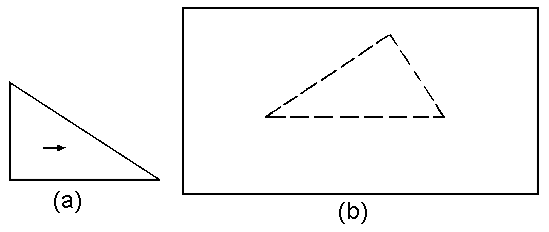
|
Fig.19a,b
|
We shall superimpose the
sample triangle on the analyzed picture each time juxtaposing one
of the sides with any contour segment of equal length. / Besides individual
segment will determine two possible juxtaposings - one at each
side. /
Obviously, that
in center it is obtained the multiple superposition (on the
number of the sides) of the reference triangle (fig.19c), that also determines,
in this case, the sought solution of problem of positional detection.
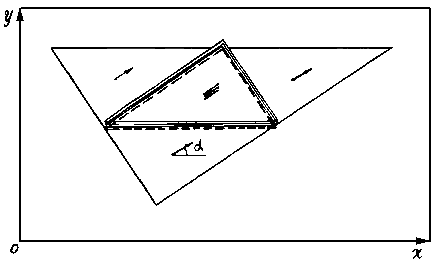
|
Fig.19c
|
This superposition
can be registered without any direct matching of contours themselves.
It is enough to draw on the reference triangle some unit
basis vector (see fig.19a), and register the superposition of this
vector (see fig.19c).
In turn, the
last problem is reduced to a search as much as possible marked
point of space of the parameters defining a position of a basis
vector on the analyzes image. Fig.19d illustrates the given situation.
On this picture the axonometric projection of space of defining parameters
is shown. In this case two parameters define coordinates of the beginning
of a basis vector, and one - an angle of declination of this vector.
Values of last parameter are registered on a vertical axis. Here the each marks is
defined by a position of a basis vector of a reference figure, at
one of possible (initial) matching its contours with an analysis picture.
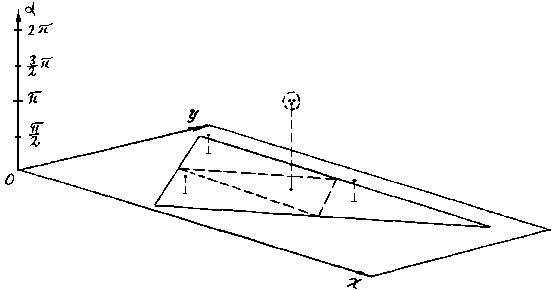
|
Fig.19d
|
It is obvious,
that registration of as much as possible marked point
demands essentially smaller computing expenditures, than direct
examination on coincidence of the standard of search object with an
analysed picture in the every possible positions generated independently
by initial juxtapositions.
Now we shall
return to our case, - when in the analyses picture initial
elements (contour segments) are detected not completely, but in
part (see fig.18a). In this case, to possible matchings of the
standard of a search figure with a separate (in part detected)
segment, will be corresponded to the line segment. This segment represents
the track left by the basis vector in the space of parameters, during
sliding of the standard concerning the separate detected segment (see
fig.18b,c). The search position, i.e. a position in which the sides
of the standard cover the greatest amount of the detected segments
corresponding a search figure, obviously, will be determined by the
point of the most powerful intersection of the generated
segments in a base space.
And at last,
in case of objects of the curvilinear form, to possible matchings
of the search figure standard to a separate approximating (contiguous)
segment, some curve of the space of determining parameters will
correspond, and to a search position - intersection of such curves.
Particularly, the positional detection process in this case represents
the following sequence of operations. The whole undistorted image of search
object (fig.20a) is registered. To this image - to the standard -
it is assigned a unit - basis - vector. For a determinacy it is possible
to consider, that as an attachment point of the barycentre of a contour
of the standard (though it is not necessary) is chosen.
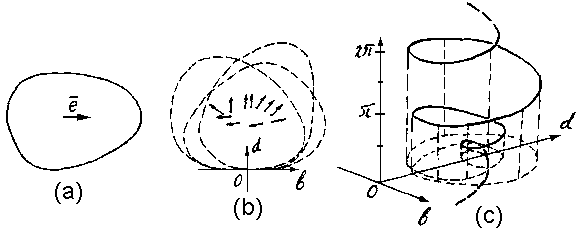
|
Fig.20
|
Then, along
a contour of the standard some formal approximating (contiguous) segment
(with continuous fine tuning branches) compulsorily moves ahead.
During such movement - slidings - the position of the standard
(its basis vector) in own frame (bOd) of the sliding formal
segment (fig.20b) is registered. The set of the obtained collections
of parameters represents some reference generated curve.
The axonometric projection of the space of determining parameters
for this case is shown on fig.20c. Here on the vertical axis the
angle between the basis vector and the longitudinal axis of segment
Ob is registered. Points of the obtained curve show possible positions
of the standard of the search figure (an its basis vector) concerning
a separate approximating (contiguous) segment.
In the process
of the positional detection itself, the reference generated
curve sequentially is juxtaposed with each segment detected
on the analyses image. Such juxtaposition represents juxtaposition
frames of the reference curve with a segment frame and the subsequent
translation of its points in a frame of the parameter space defining
a position of the basis vector on the analyses image. Thus to values
of angles the declination value of a flowing segment is added. Now points
of each generated curve show, what positions the standard of
search object (its basis vector) concerning the given detected segment
can occupy at sliding the standard with the contour on this segment.
Thus, the problem
of positional detection of flat objects is reduced to the search
of intersections of the similar curves corresponding to individual
approximating segments. An example for two segments is shown on
fig.21. Here xOy - a frame of the image. On the vertical axis the angle
between the basis vector and horizontal axis Ox is registered.
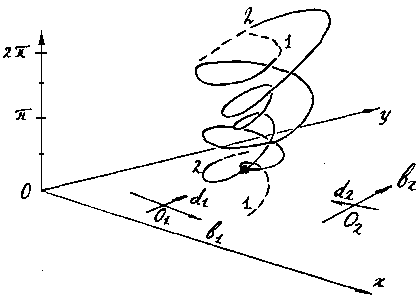
|
Fig.21
|
The cross point
of the majority of the generated curves defines such position
of the standard of search object (its basis vector) at which the
contour of the standard simultaneously coincides with the greatest
number of the detected segments. It, obviously, also is a solution
of the considered positional detection problem.
It is necessary
to note, that the considered algorithm does not assume an obligatory
continuous smoothness of contour boundaries of search objects.
For serviceability of the algorithm it is necessary, that the number
of singular points of these boundaries (angles) was finite. Objects
should not remind a hedgehog or a cloud. Presence
of separate smooth pieces is required only. It, as a rule, is ensured
with the process engineering of operations on shaping objects: cutting,
planing, grinding, stretcting, forging, etc., and also the physics
of the nature: forces of inertia, a superficial tension; regularities
of processes of cleaving, cracking, etc., etc. The reference curve is
under construction on such smooth pieces and represents set of separate
curves (space of search parameters), corresponding these pieces.
Also absence
on the analyses image of separate parts of the contour boundaries
corresponding to the search object is obvious, that does not render
a fatal influence on outcome of a positional detetion. In that
case only a potency of a search cluster accordingly will decrease.
3.3. GENERAL STATEMENT OF THE PROBLEM.
To compare the
suggested positional detection procedure to already available
ones, to show its place among them, and also to offer possible expansions
of the use domain, we shall give a formal statement of the detection
problem by means of registration of an unison of parametrical hypotheses.
Let there is
a set of hypotheses H about some physical phenomenon and
a set of facts T which can be registered at research of this
phenomenon. Thus it is known, that each hypothesis h H is confirmed by the defined subset of facts
T(h)
H is confirmed by the defined subset of facts
T(h) T. Further each such subset we shall name a factogram
(factograph) of the given hypothesis.
T. Further each such subset we shall name a factogram
(factograph) of the given hypothesis.
Usually, the
problem of a hypothesis choice h_o H, corresponding to some set of facts T_o
H, corresponding to some set of facts T_o T, further named a set of the realized facts, is put
and solved as a problem of searching of a hypothesis which factogram
has a maximum conformity with this set:
T, further named a set of the realized facts, is put
and solved as a problem of searching of a hypothesis which factogram
has a maximum conformity with this set:

Where
S - the
function defining a conformity between sets of the facts.
In the simplest
case the conformity is defined by number of the elements simultaneously
belonging to both compared sets:

Where
| E(t,T(h)) = |
1, if t T(h);
T(h);
0, if t T(h).
T(h).
|
It is possible
to tell, that in this case it is prospected the hypothesis CONFIRMED
by a maximum quantity of the realized facts.
Now we shall
remark, that the same problem of search of the hypothesis corresponding
to the realized facts, it is possible to put as a problem of search
of the hypothesis GENERATED simultaneously by the greatest amount
of these facts:

Where
H(t) =
|
{h|h H,t
H,t T(h)} - a subset of the hypotheses generated by
the individual fact, i.e. confirmed by this fact. Further each such
subset will refer to as a hypogram (hypograph) of the concrete fact.
Fig.22 picturesquely illustrates the essence of introduced concepts.
T(h)} - a subset of the hypotheses generated by
the individual fact, i.e. confirmed by this fact. Further each such
subset will refer to as a hypogram (hypograph) of the concrete fact.
Fig.22 picturesquely illustrates the essence of introduced concepts.
|
| E^(h,T(t)) = |
1, if h H(t);
H(t);
0, if h H(t).
H(t).
|
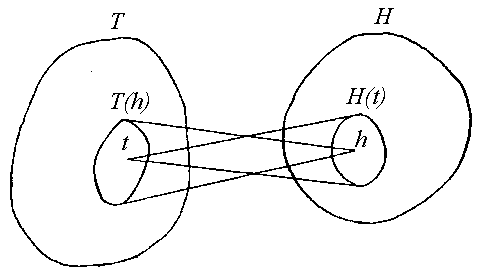
|
Fig.22
|
Namely this
sense is put in the concept of search by means of registration of an unison
of parametrical hypotheses.
Before such
kind of search named as search by a principle of accumulation of hypotheses
[3]. The modified name reflects the essence
of the process more precisely. The former name concerns to particularities
of realization. The considered statement of the search problem
naturally leads in its realization, based on use of some set of accumulators,
isomorphic to a set of sorted out hypotheses. In this case each next
fact is taken into account one time, by a mark of accumulators which
correspond to the hypotheses which are included in a hypogram, generated
by this fact. After the termination of search of all facts and marking
of accumulators it is necessary to register an accumulator having a
maximum number of scores. This accumulator also defines, on a new nomenclature,
the unison - consent of the generated hypotheses.
Comparing the
first and second kinds of search, first of all it is necessary
to tell, that outcomes obtained with their help are in essence equivalent.
It is caused by that an amount of confirmations of any hypothesis
obviously equally to number its generations.
Rationality
of use of this or that hypothesis search mode corresponding to the realized
facts, depends, first of all, on a mode of definition of a set of hypotheses
H subject to examination. Advantages of the technique of accumulation of
hypotheses appear indisputable when hypotheses are directly generated by
individual facts on which examination of these hypotheses, namely when the
set of hypotheses is defined as is made also:

In this case
there is no repeated return to already overlooked facts expressing
in evaluation of the conformity function.
If character
of a problem allows to limit somehow number of hypotheses in
comparison with what is generated by all realized facts separately
(that rather frequently takes place) expenditures on designing
of an accumulator can appear unjustified. In this case it is possible
to be limited to direct examination of confirmation of the factograms
corresponding to the available hypotheses. It is necessary to take
into account concrete particularities of a decision problem.
At a solution
of the positional detection problem, the role of the facts
is played with separate elements of analysis images. These elements
- initial features, under the supposition, correspond to some elements
(fragments) of search objects. Each initial feature chosen in an
analysis picture, generates a set of hypotheses about parameters of
the search object, i.e. a hypogram. Thus to each hypothesis the point
of space of the parameters defining a position and orientation of object
corresponds, and to an individual hypogram - the defined set of such
points. Further for simplicity these point sets will refer too as hypograms.
The search position of object is defined by a cross point of hypograms.
Naturally, generally it is necessary to speak about this point as about
a point of a cluster (clusterization), i.e. about a point in which
neighbourhood the greatest number of hypograms hits.
3.4. HYPOTHESES UNISON IN THE POSITIONAL DETECTION.
The positional detection algorithms based on the
cluster analysis of the space of search parameters, draw attention
of experts on visual recognition of objects. The majority of researches
of this direction goes back to the widely known Hough transform [7, 20
- 27]. The essential shortage of these algorithms consists that
the search parameters are considered as parameters of some abstract
transformations of the elements of the reference image into similar
elements of the analysis image [22,
25]. Such statement of a problem hampers
understanding of logic of build-up and further improvement of similar
detection algorithms. In particular,
it leads in enough abstract reasonings on "collinearity" of contour
points [7, 28] or about "not dot transformations"
[21, 22]. It is necessary to
prove equivalence of the outcomes obtained with the help of these
algorithms and recognition algorithms in which basis
comparison with the standard [29]
lays.
The substantial
approach to positional detection problem as to a search
problem of superposition of modelling images of the search objects
generated independently by individual fragments (features) of these
objects [19], directly suggests parametrization
methods. Obviously, as the search parameters it is necessary to use
parameters of the simplest configurations of structural elements rigidly
connected to the standard of search object and permitting completely
to define its position and orientation. Thus, the essence of the detection problem is reduced to
search of superposition of such configurations. In the case of flat objects
a basic configuration is any unit vector assigned in the beginning to the
object standard. If the scale changes, respective variation of length can
be assigned to this vector. In the case of 3D bodies two unit vectors starting
from one point can be a basis structure. The position of such structure is
determined by six parameters: three ones set coordinates of the attachment
point, two ones - orientation of a principal vector of this design, and one
parameter - rotation of an auxiliary vector around of principal one. It is
possible to use the Eulers angles. In this case the basis strucure will represent
the thriplet of mutually perpendicular vectors which are starting from one
point. In all these cases an individual hypogram will be defined by set of
positions of the basic structure which it can occupy concerning the given
initial feature (fragment) of the search object.
The suggested
ontological scheme represents generalization and attempt of more
deep clearing up of the essence of similar algorithms. First of all,
this scheme directly shows equivalence of the outcomes obtained with
the help of this or that technique of object positional detection. A vivid example of it
is work of a matrix decoder which can be considered and as parallel
comparison with the standard (set on the address register) and as
search of intersection (cluster cells) of hypograms assigned
to address buses. It is necessary to note, that the Guzman idea about
promotion of global hypotheses on the base of local data have served
as initial push in the direction of idea of accumulation of hypotheses
[30], and the Walts idea of about
search of a consistent (compatible) mark of contour edges [31] - for the idea of superposition
of models .
Probably, the
proposed ontological scheme will serve further movement to understanding
of the essence of various search kinds and correlation between them.
The considered example, where the hypothesis choice is carried out
with simple calculation of binary voices, reflects only the simplest
case. A purpose of this example - to show basic equivalence of indexes
of confirmation measure and measure of generationess of
hypotheses, in the simplest case - the binary count of the facts. Generally
the membership functions can have more complicated view: to accept a continuous
spectrum of values (for example to be fuzzy), to accept negative values
(individual facts can refute some hypotheses), etc., etc.
3.5. MAIN PARTICULARITIES OF APPLICATION OF UNISON-TECHNIQUE
OF POSITIONAL DETECTION.
Further, the technique of positional detection based on registration
of unison of parametrical hypotheses will be named also simply as unison-technique (unison-detection ets.).
Use prospectivity of thise technique in comparison with the technique
of direct examination of hypotheses confirmation, which in this case
can be named examination on conformity with models-standards, depends
on concrete particularities of the problem solved.
The technique
of direct examination on conformity with models is efficient when
the search of small amount of hypotheses is required, for example,
when there is a possibility of efficient detection of the high informative
fragments essentially bounding a set of generated hypotheses or when
character of a problem allows to apply any strategy reducing search.
In particular, it concerns to the case when the conformity measure on an
admissible set of hypotheses is the smooth function having limited number
of extremums. In this case for search of its maximums it is possible to
use gradient procedures. Such search strategy, for example, is applied
in the proposed representation mode of contour boundaries in terms of
contiguous segments.
In those cases
when on a problem there are only low informative initial features
(facts), each of which separately poorly limits an amount of admissible
hypothesises, advantages of the hypotheses accumulation technique
can appear resolving. As here, instead of multiple and, as a rule,
protracked evaluation of the conformity function, a simple coincidence
of points in own space of hypotheses is registered.
As well as by
search, in which base evaluation of the conformity function lays
(search by principle of direct hypothesis test), the choice of initial
features is a key defining boundaries of applicability of hypotheses
accumulation technique. If to use the most universal initial features
- contour points [20 - 22], computing
resources of modern computers allow to solve practically only the problem
of positional
detection of two-parameter objects (in
particular, infinite straight lines).
To limit number
of generated hypotheses up to a comprehensible level, at the solution
of more complicated problems of geometrical detection (with a big number of
unknown parameters) it is necessary to use more complicated initial features
(fragments) of search objects too. The basic difficulty thus will be, that
the following on the complexities, the most natural initial features,
- the rectilinear contour segments connecting points of inflection - sharply
limit a class of recognition objects. As it was already marked,it is impossible
to divide univalently the contour boundaries of the objects having smooth
contours (fig. 20a) into separate segments. Approximating segments on such
contours generally cannot be fixed legiblly enough. Thus, each segment generates
rather extensive - sliding - set of possible positions of the search
object. Here by the best way of detection by the registration of
unison of parametrical hypotheses proves.
The basic difficulty
at realization of such positional detection algorithm consists in
necessity of steady definition of orientation and cross position of sliding
approximating segments in the case of real curves, when these curves
are set discretely and deformed by various interferences.
If to define
these directions by short segments (to provide common universality
of the algorithm, irrespective of the form of objects), in real conditions
casual oscillations of these segments will lead to essential oscillations
of the base vector. For example, if to use contour elements obtained
directly with the help of the Hueckel's operator [5, 6] (as it was offered in [23]). In this case, oscillations of the
ends of obtained elementary contours with an amplitude plus or minus one
point, at diameter of the entering piece in 7 points of the raster, on the
distance of 50 points (that corresponds to average distance up to the center
of a figure in diameter in 100 points), lead to oscillations of the
basis vector with amplitude of 15 raster points (50/(7/2)).
In this case
it is necessary to hope only that the searched correct solution nevertheless
will turn out due to statistical averagement. Such solution
assumes the organization of the count of a great numbery of the hypograms
generated by individual elementary segments. The extended machine
memory for storage of a hypotheses accumulator is required. Significant
expenditures of machine time for the procedure of hypotheses accumulation
and the analysis of the obtained (in an accumulator) pictures are necessary.
On the other
hand, the suggested in [25]
sliding matching on extended pieces of contour lines basically can
satisfy stability requirements. However, it does not ensure universality
as it is limited only to the case of rectilinear segments. Though and
for this case here it is necessary to expect essential difficulties owing
to absence of an effective mode of segment approximation.
In the proposed
scheme of realization of unison-procedure the sliding segments, which
are simultaneously meet the requirements of universality and stability,
namely - contiguous segments, are used. Virtues of these segments
are defined by that the use of bell-like memberships functions included
in their basis allows to tune out effectively from jamming. Bell-like function enables
correctly - on a maximum - to lean on length of juxtapositioned
contours.
As the result,
it was possible to construct an jam-resistant, costructivelly realizable
procedure of positional detection of arbitrary form objects.
3.6. PROCEDURAL PARTICULARITIES. RESULTS OF EXPERIMENTS.
The proposed positional detection algorithm has been realized
in the language FORTRAN (a small part - on the autocode).
Build-up of a reference hypogram of the search object is
carried out under its full undistorted image. As an attachment
point of the basis vector the barycentre of contour boundaries gets
out. During build-up of a reference hypogram the step of movement of
a formal contiguous segment is continuously arranged with the help
of feed-back so that to keep adjacent points of a reference hypogram
within the limits of one zone into which the space of search parameters
is supposed to divide. This space is represented as set of rectangular
zones.
The size of zones
on an axis defining declination of a basis vector, gets out according to
a condition of approximate equivalence of shift ( L) and turn (
L) and turn ( A) a reference figure:
A) a reference figure:  A=
A= L/R, where R - radius of object. This value is calculated
as arithmetic mean lengths of the radiuses - vectors directed from
a barycentre to each points of contour boundary.
L/R, where R - radius of object. This value is calculated
as arithmetic mean lengths of the radiuses - vectors directed from
a barycentre to each points of contour boundary.
Hypograms of
the contiguous segments detected on the analysis image are obtained
by "juxtaposition" to them of a reference hypogram (thus coordinates
of its points are accordingly transformed).
Hypograms are
set pointelly with a step commensurable with linear sizes of the
zones. Therefore, marking in the intersection field of several hypograms
can not give one zone which would be marked simultaneously
with all these hypograms. To overcome similar accidents of a
discrete mark, in the program realizing the algorithm the averaging of
obtained pictures is made within the limits of adjacent zones. For each
marked zone its weight - the arithmetical sum of contents of adjacent
zones - is calculated. Contents of the zone are a number hypograms
marked it. 27=3x3x3 zones are considered as adjacent, including central
one. The separate cluster is registered as a zone which weight exceeds
weights of the neighbours. The central point of such zone starts a cluster
point. As a whole, such operation is called as smoothing.
In the program
realizing the algorithm, the information only about marked zones
is remembered. For this purpose some array is assigned. The entry
is executed with the help of hashings [Appendix_3.6.A].
Reference hypograms
of recognition subjects - insoles, an iron and a case from glasses
(see fig.13) - were constructed on their separate images. The sizes
of search parameter space zones on the axes defining a position of
an attachment point ( L) was equal to eight (8) points of the raster. On the
axis defining declination of the basis vector (
L) was equal to eight (8) points of the raster. On the
axis defining declination of the basis vector ( A) it was equal 0.1 radians. The linear size of the zones
got out approximately equal to a minimum distance on which two parallel
contours are distinctive. In this case this distance - solution
- was defined by the diameter of entering area of the Hueckel's operator
with which help elements of contour boundaries were selected. Diameter
of this area was 7 points of the raster [2.2.]. The concrete value
"8" has been chosen as the nearest power of 2, that essentially
accelerates operation of definition of the zone number (instead of division
- shift...) . The angle sizes of zones according to above indicated
equivalence criterion of shift and turn for figures with average radius
of 50 raster points (average radius of objects in this case).
A) it was equal 0.1 radians. The linear size of the zones
got out approximately equal to a minimum distance on which two parallel
contours are distinctive. In this case this distance - solution
- was defined by the diameter of entering area of the Hueckel's operator
with which help elements of contour boundaries were selected. Diameter
of this area was 7 points of the raster [2.2.]. The concrete value
"8" has been chosen as the nearest power of 2, that essentially
accelerates operation of definition of the zone number (instead of division
- shift...) . The angle sizes of zones according to above indicated
equivalence criterion of shift and turn for figures with average radius
of 50 raster points (average radius of objects in this case).
At such zones
sizes of reference hypograms of the search objects contained accordingly
85, 60 and 45 points.
During accumulation
of hypotheses about an insole position (on fig.13), 1784 zones have
been marked. From them: fourfold - 1, threefold - 3, twice - 47,
one time - 1733 (time of accumulation of hypotheses 1,5 s; computer efficiency - 1
million operations from a floating point). Among these zones after
operation of smoothing 18 separate clusters (smoothing time 1,0
s) have been registered. Relationship of weights of these clusters
is shown on fig.23.
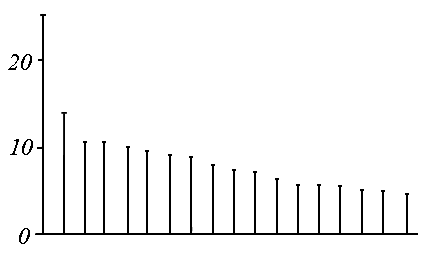
|
Fig.23
|
Histograms of
maximum weight zones of the most powerful clusters are shown on
fig.24.
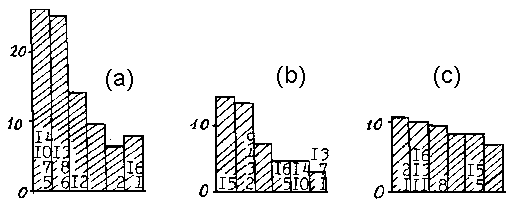
|
Fig.24
|
Each histogram
shows values of the most powerful zones situated on various distances
from the central zone. Distances are registered on horizontal axes
and measured in terms of a digitization step. Numbers of the hypograms
for the first time appearing on the given distance are present on the
histograms. Indexing of segments see fig.25.
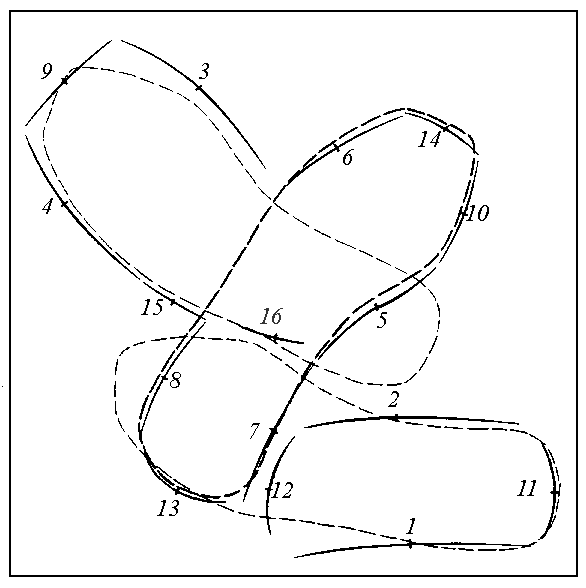
|
Fig.25
|
On fig.25 fat
primes show the position of the standard of the search object, defined
by the central zone (the central point of this zone) of the most
powerful cluster (fig.24a). On the same picture thin primes show
positions of the standard, defined by two most powerful false
clusters (see fig.24b,c).
In [Appendix_3.6.B] the
problem of common expediency of smoothing operation is considered.
Experiments were
carried out with various variants of disposition of contiguous segments on
the contour boundaries of search objects. At attempts to fix contiguous segments
on represantation contours [2.4.] the most various dispositions of these
segments were obtained. In particular, for an insole it has been analysed
about ten variants, which include approximately 70 (7 segments õ 10
variants) different positions for a separate contiguous segment (including
the most unsuccessful, corresponding to the pieces of significant curvature).
In all these cases the point of parameter space corresponding to the
true position of the search object on the flowing image was in the
central zone of the most powerful cluster. Thus all hypograms generated
by segments contiguous to a search object contour hitted (by any
points) if not in this zone, in the last resort in one of adjacent
zones.
The experiments
carried out in this way have confirmed basic serviceability of the
considered positional detection scheme of arbitrary form
objects and have shown a possibility of its to constructive realization.
3.7. THE
POSSIBLE IMPROVEMENTS.
The accepted concept of equivalence of contiguous segments
is intended for the worst situation - a case of very smooth contours,
with feebly marked changes of curvature. Naturally, in general case at
matching of contiguous segments it is necessary to take into account,
even roughly, parameters of their branches. With all evidence it is shown
with exibited examples of false situations of the search object (see fig.25).
If the insole heel is approximately entered in the contiguous segments
representing a glasses case contour and an its nose - in an iron contour,
confirmation of the rectilinear piece of contour boundary of search object
by curvilinear segment N~13 and the curvilinear piece by rectilinear segment
N~2 only on the basis of their mutual tangency evidently is not justified.
Organization of hierarchical count of hypograms, i.e. accumulation of hypotheses
by way of their probability is a problem of further researches. And this
problem has a basic value as thus the relative weight of false cluster
points should decrease considerably.
Research of the
problem of use of configurations of initial matching (initial fragments) built
of several (first of all from pairs) adjacent contiguous segments seems to
be rather prospective also.
For reduction
of computing expenditures by the hypotheses accumulation principle
it is possible to make search iterativelly: initially to work with big
zones and rough representation of hypograms and then to analyze intersection
zones using more precious representation and smaller zones.
Other mode of
reliable registration of hypogram intersections (without use of smoothing)
consists in marking of all tops of each zone. At increase of dimension
of the space of search parameters expenditures in additional memory
can appear smaller than on an evaluation of the local (neighboring)
sums. In this connection it would be expedient to solve the problem of
subdivision of space of parameters into zones having a minimum number
of tops (for two-parameter space they are triangles, for three-parametrical
one - tetrahedrons, etc.).
Naturally, realization
of the suggested scheme can appear too bulky for direct positional identification of complicated objects,
i.e. objects which contour boundaries demand for their description
about ten and more contiguous segments. Here the suggested scheme can
be applied to detection of separate fragments
of such objects used further for a final geometrical detection problem solution with
the help of structural methods or subsequent direct matching of models (standards)
of search objects with analysed pictures. As a whole, in detection
of such fragments already enough legiblly corresponding to separate
parts of actual objects it is possible to see the basic applicability
of the suggested positional detection scheme.
It is possible,
that the count of more thin performances of contiguous segments and
also improvements of realization technics of the identification scheme will enable to
spread its to positional detection of 3D bodies on their images,
anyway their fragments. Thus, for restriction of volume of hypograms
a use of the contiguous ("sliding") surfaces describing a distance
image essentially would help. This description can be obtained as a
result of the analysis of half-tone pictures, methods of stereosight
or direct mesurement of distance (for example, using laser technics).














